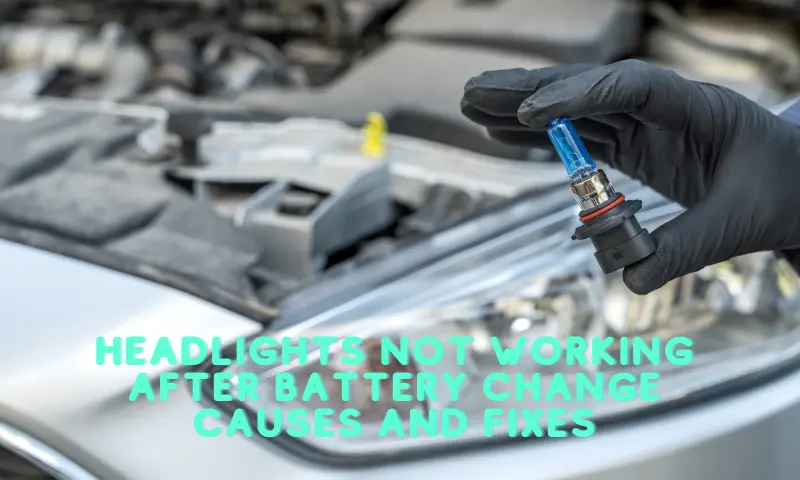Your car headlights, turn lights, and many other lights and parts are enabled by the electrical connection in your vehicle. All electric current currents get their power from the battery. Once you disconnect the battery, the entire electrical system of the vehicle shuts down.
‘But why do the ‘headlights won’t work’ message pops up after changing my battery,’ you may want to ask. Could be electrical or a mere physical issue with the bulbs? Give me a few minutes to walk you through it. I’ll also recommend the best fix. Stay connected.
How the Headlight-Battery Connection Works
I think I need to touch on the mechanism between the battery and your car headlights. This can give us some direction when troubleshooting flickering or faulty headlights.
When you switch on your car headlights, the switch triggers a headlight relay. The relay helps switch on the power between high-beam and low-beam headlights. When the relay goes bad, it won’t establish the needed electrical connection between the battery and the headlight bulbs. This way, it will only activate and give power to the high-beam filaments, and not the low beams.
The two fuses –a 30 amp headlight fuse and a 15 amp meter future are integrated as headlight protectors, regulating the amount of power that gets into the headlight. Plus, the fuses also protect the wiring. All of these components have to be in good condition. Otherwise, the headlight systems will collapse, causing the headlights to stop working.
Now, imagine these mechanisms are distorted, what do you suppose will happen? Your guess is as good as mine. But one sure thing is that the headlights won’t work. Let me take you through the specifics of why the headlights will fail after the battery change.
Cause and Fixes of Headlight Not Working After Battery Change
Here are possible causes and fixes for headlights not working after replacing the battery:
Voltage spike
Car battery voltage spike occurs due to several reasons and you must first identify the cause. However, my over-a-decade experience tells me that the major cause of voltage is internal changes in voltage use. Alternatively, a wiring short can be a major cause.
For example, if you jumpstarted the old battery a few minutes before installing the replacement battery, it might have caused the voltage spike. When this happens, power will surge, causing the headlights not to work. Other issues will likely happen along the line.
How to Fix
The thing to do is to trace the source of the spike. A car battery voltage spike can come from the starter motor. It can also be inductive spikes which can be due to sudden reduction or removal of power supply to the inductor.
Whatever it is, as you switch on the engine, monitor where the spike is coming from. You will need to observe the scope across the two—negative and positive—battery terminals.
Blown headlight fuse
By default, the headlight system operates with two different fuses. The headlight fuse and the meter fuse, with the latter boasting 30amp while the latter is a 15amp fuse. The fuses are in place to break or blow the circuit in case excessive current passes through before it gets to the headlights. However, once they’ve blown themselves, the fuses will not be able to stop the surplus power from getting to the headlights. Hence, the headlights will blow and so stop working. Once either one or two of the fuses are blown, you will experience flickering, malfunctioning, or not-working headlights
How to Fix
The first to say is that whichever the case, you’ll need to check the system further. Inspect the circuit and diagnose the issue to ascertain which of the fuses to replace. Regardless, a blown fuse can only be replaced.
Failed Headlight system
As I have previously explained, failure of any of the components will cause the headlight to stop working. The system is connected properly to ensure normal functioning. If the fuse is blown, the bulbs are faulty, and the taillights or high beams aren’t working as properly as they should, then the headlights won’t work fine. It’s no rocket science.
How to Fix
The best thing to do is to observe the way these components started to fail. This way, you can easily backtrack and come up with a possible remedy. Troubleshooting a failed component starts with understanding its functions and operational mechanism. You may not be able to remedy some of the components. Some will need repair; others will be a complete replacement. Perhaps, driving to a mechanic will be your best bet.
Turned off headlights switch
Hitherto, you’ve checked that all the components are in good condition and you can confirm that there is no voltage spike. There’s something you may have overlooked. It is the headlight switch. You or your dealer may have turned it on during the battery replacement. If the switch is in the ‘off’ position, the headlight won’t work until you turn it to the ‘on’ position. The ‘off’ switch disables the auto headlights.
How to Fix
Fixing this problem is a no-brainer. Check if the switch is turned completely leftward to disable the auto headlight. Switch on the headlights by simply putting the headlight in the ‘on’ position. Alternatively, the auto headlight is the best bet. You can switch the button at 12 o’clock for the auto.
Read also:
Where are the Headlight Adjustment Screws
3 Reasons Why One Headlight Dim And The Other Bright
FAQs
Are the bulbs the problem if the two headlights stop working?
No. Except there is a time lag between one burnt-out headlight and the other, you can’t suspect faulty bulbs. To be sure that one of the bulbs is burned out, first, check if there’s power in the headlights.
Start by connecting your voltmeter negative lead to good ground and touch the positive terminal to feel the power. If the problem is faulty bulbs, then you’ll notice one end of the battery indicates voltage while the other terminal will show nothing.
Final Thoughts
The headlights can be a major culprit when you change your car battery. The turn signals, exterior lights, and the tachometer aren’t spared either when this change occurs. If you observe the headlights aren’t working, it’s not unusual, so you won’t need to panic. Take your car to a technician. They can check and tell precisely where the problem comes from. You can take the fixes highlighted above only if you have some level of DIY experience. In all, remember, you cannot drive at night without the headlights on. It’s not safe for you and other road users.

